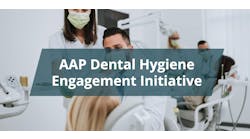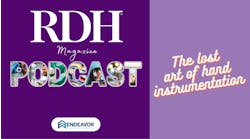Improving Practice Communication Through Technology.
by Christina Nicolini, RDH
Effective communication is vital in our profession. It greatly impacts our relationships with colleagues and patients, as well as the overall function and atmosphere of the dental practice. Because each patient has different expectations concerning his or her care, it is necessary to understand those expectations and communicate them to the entire dental team. The patient’s positive experience with the practice is contingent upon the frequency and professional level of communication before, during, and after appointments, as well as the consistency of the messages communicated by the dental team.
Technology can aid in and expedite the communication process. Whether patients are seen every week or every six months, each team member plays an integral part in treating them in an efficient, timely manner. Patients must be confident that the dental team constantly cooperates and shares information, because the team’s communication is the underpinning of the patient experience. By effectively utilizing communication among the entire dental team – doctor, hygienist, receptionist, assistant – and with patients we can all help to ensure efficiency of the practice and high-quality patient care.
Communication-Focused Technology
Communication and technology go hand-in-hand to play an integral role from start to finish of the patient appointment. First, technology facilitates telephone and e-mail reminders to confirm appointments long before a patient even enters the practice. In the author’s experience, technology provides information at the receptionist’s fingertips so he or she may greet patients by name when they first enter the office, while updating their insurance and medical history information within our clinical and practice-management software.
Secondly, to ensure timely progression of the patient schedule, each member of our staff wears a headset for instant communication. The receptionist lets me know when the patient has arrived, and allows me to notify the receptionist instantly if I am currently with another patient, without ever having to leave the operatory. The receptionist can then immediately communicate appointment timing to the patient. Additionally, headsets are used by the team to alert the doctor when the patient is ready for an exam, at which time the doctor can immediately relay back his or her availability.
Headsets allow the dental team to communicate internally and instantaneously, preventing staff from moving around the office inefficiently. If one of us has a question for another staff member, we can discreetly communicate over the headset without getting up or disturbing the patient. Often patients comment positively on the headsets. They notice the efficiency of the practice when three staff members show up chairside simultaneously. With this technology, our office staff is able to maintain the day’s schedule, and the entire process flows smoothly.
An additional form of instant communication that we use in our office is the Messenger feature in Patterson EagleSoft clinical and practice-management software. With Messenger, the team can communicate instantly from one desktop to another. Electronically, we can all access patient records, X-rays, digital images, and treatment plans at any time with complete patient confidentiality and privacy. We can quickly relay messages regarding finances, follow-up appointments, home care, or other issues to the receptionist before a patient leaves. The patient is pleasantly surprised to have the receptionist discuss and finalize these details prior to leaving the practice. Thus, the software has the ability to reinforce the positive patient experience.
Lastly, a patient never walks out of the office without a treatment plan for the next six to 12 months – a plan that is generated with a tap of a few computer keys within our clinical and practice-management software. Whether the plan involves a simple check-up or a full-mouth reconstruction, that information is provided to the receptionist so that future appointments are scheduled before the patient leaves. The patient then returns to the front desk where the receptionist discusses financial options, as well as next steps in the treatment plan.
Treatment-Focused Technology
A number of technologies in the office facilitate the treatment process. By using a name or contact information, it is easy to pull up the computerized patient record and find all types of treatment information for an individual. Two invaluable tools throughout the treatment process – digital imaging and patient-education software – are beneficial to both patient and professional alike. Although these are two technologies that could be discussed in greater detail, a brief highlight of each and how they relate to treatment follows.
Digital imaging has proved to be an instrumental tool in communicating treatment options to patients. Digital photography allows us to show patients virtually any condition occurring in their mouths. In our practice, we save digital images within each patient’s treatment plan in our clinical and practice management software. Ordered by priority of treatment by the doctor, there is no confusion for the patient or the staff. Our software allows you to go directly to that treatment every time.
After showing patients the condition digitally, we are then able to educate them more thoroughly on treatment, again with the use of technology. CAESY patient education software allows us to show X-rays and other images to the patient in an interactive and educational way. Other patient-education programs include Chairside 2006 by Consult-Pro, MedVisor by MedVisor Dental, Orasphere by Orasphere Corp., and Treatment Pro by Sullivan-Shein. Brief presentations on relevant conditions and treatments reinforce the treatment process and supplement our explanations. Sometimes patients have a hard time understanding why treatment is necessary if they are not experiencing pain or have never had a prior condition. By showing an image of the same condition, patients are more likely to understand why treatment is necessary. For example, every patient receives a periodontal exam and a review of his or her chart so progress can be demonstrated over time. If a patient starts out with six millimeter pockets, we treat the patient and later show him or her a healthy three millimeter pocket, illustrating the improvement made over time. Only then – through technology – can the patient truly see and understand the ramifications of disease or bone loss.
Take-Home Technology
Patients are often overloaded with information during the appointment. For this reason, we create handouts using our clinical and practice management software for them to take home when they have additional time to absorb the information provided, making it easier for them to recall everything we discussed. We create and organize standard forms or handouts in advance for a variety of conditions. This allows us to quickly make them available to patients with the click of a button. My patients will often say, “I need to discuss this with my spouse,” and access to a handout typically means the practice receives fewer phone calls later with questions. Alternatively, some patient-education programs, such as ShowCase within CAESY Enterprise, allow users to burn presentations and images to a CD for patients to take home. Take-aways have become such a standard in our practice that a surprising number of patients request them.
Patient-Centered Technological Practices
The entire communication process between patients and the dental team is aided by technology. Technology streamlines and enhances verbal communication in the office, proving useful not only in the treatment process, but also ensuring that the everyday functioning of the practice is smooth and efficient. By ensuring a positive, engaging experience for patients, staff can heighten patient satisfaction with their care and help to increase their commitment to oral health. Technology in the hands of a team with great clinical skills and processes allows for a truly patient-centered practice.
About the Author
Christina Nicolini, RDH, works in the Annapolis, Md., area where she practices in a periodontal office. She earned her associate’s degree from Temple University and graduated cum laude with a bachelor’s degree in dental hygiene from Thomas Jefferson University in Philadelphia, Pa. As a licensed registered dental hygienist in three different states, Nicolini has also been active in the American Dental Hygienists’ Association. She can be reached at [email protected].
Tips for EnhancingPractice Communication
- Get to know your clinical and practice-management software program. A little time dedicated to learning its capabilities will uncover many tools and features you did not realize you had at your disposal.
- Set up standard programs and patient-education forms for routine procedures to expedite treatment.
- Technology at home translates to an increasingly educated consumer base. Talk to your patients about Web sites they are visiting, where they are getting information, and stay informed about their concerns.







